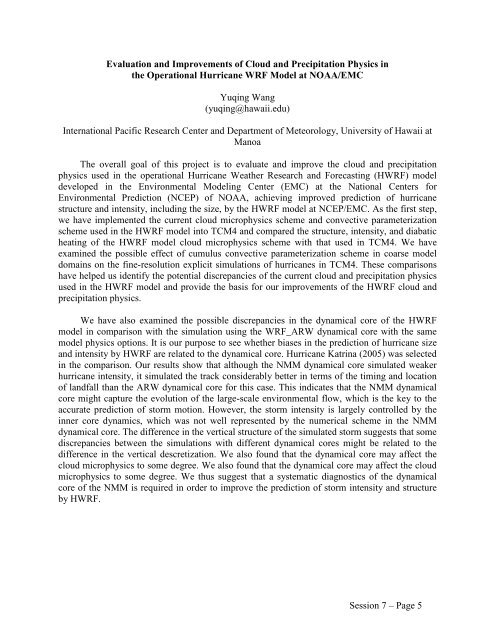65th IHC Booklet/Program (pdf - 4.9MB) - Office of the Federal ...
65th IHC Booklet/Program (pdf - 4.9MB) - Office of the Federal ...
65th IHC Booklet/Program (pdf - 4.9MB) - Office of the Federal ...
You also want an ePaper? Increase the reach of your titles
YUMPU automatically turns print PDFs into web optimized ePapers that Google loves.
Evaluation and Improvements <strong>of</strong> Cloud and Precipitation Physics in<br />
<strong>the</strong> Operational Hurricane WRF Model at NOAA/EMC<br />
Yuqing Wang<br />
(yuqing@hawaii.edu)<br />
International Pacific Research Center and Department <strong>of</strong> Meteorology, University <strong>of</strong> Hawaii at<br />
Manoa<br />
The overall goal <strong>of</strong> this project is to evaluate and improve <strong>the</strong> cloud and precipitation<br />
physics used in <strong>the</strong> operational Hurricane Wea<strong>the</strong>r Research and Forecasting (HWRF) model<br />
developed in <strong>the</strong> Environmental Modeling Center (EMC) at <strong>the</strong> National Centers for<br />
Environmental Prediction (NCEP) <strong>of</strong> NOAA, achieving improved prediction <strong>of</strong> hurricane<br />
structure and intensity, including <strong>the</strong> size, by <strong>the</strong> HWRF model at NCEP/EMC. As <strong>the</strong> first step,<br />
we have implemented <strong>the</strong> current cloud microphysics scheme and convective parameterization<br />
scheme used in <strong>the</strong> HWRF model into TCM4 and compared <strong>the</strong> structure, intensity, and diabatic<br />
heating <strong>of</strong> <strong>the</strong> HWRF model cloud microphysics scheme with that used in TCM4. We have<br />
examined <strong>the</strong> possible effect <strong>of</strong> cumulus convective parameterization scheme in coarse model<br />
domains on <strong>the</strong> fine-resolution explicit simulations <strong>of</strong> hurricanes in TCM4. These comparisons<br />
have helped us identify <strong>the</strong> potential discrepancies <strong>of</strong> <strong>the</strong> current cloud and precipitation physics<br />
used in <strong>the</strong> HWRF model and provide <strong>the</strong> basis for our improvements <strong>of</strong> <strong>the</strong> HWRF cloud and<br />
precipitation physics.<br />
We have also examined <strong>the</strong> possible discrepancies in <strong>the</strong> dynamical core <strong>of</strong> <strong>the</strong> HWRF<br />
model in comparison with <strong>the</strong> simulation using <strong>the</strong> WRF_ARW dynamical core with <strong>the</strong> same<br />
model physics options. It is our purpose to see whe<strong>the</strong>r biases in <strong>the</strong> prediction <strong>of</strong> hurricane size<br />
and intensity by HWRF are related to <strong>the</strong> dynamical core. Hurricane Katrina (2005) was selected<br />
in <strong>the</strong> comparison. Our results show that although <strong>the</strong> NMM dynamical core simulated weaker<br />
hurricane intensity, it simulated <strong>the</strong> track considerably better in terms <strong>of</strong> <strong>the</strong> timing and location<br />
<strong>of</strong> landfall than <strong>the</strong> ARW dynamical core for this case. This indicates that <strong>the</strong> NMM dynamical<br />
core might capture <strong>the</strong> evolution <strong>of</strong> <strong>the</strong> large-scale environmental flow, which is <strong>the</strong> key to <strong>the</strong><br />
accurate prediction <strong>of</strong> storm motion. However, <strong>the</strong> storm intensity is largely controlled by <strong>the</strong><br />
inner core dynamics, which was not well represented by <strong>the</strong> numerical scheme in <strong>the</strong> NMM<br />
dynamical core. The difference in <strong>the</strong> vertical structure <strong>of</strong> <strong>the</strong> simulated storm suggests that some<br />
discrepancies between <strong>the</strong> simulations with different dynamical cores might be related to <strong>the</strong><br />
difference in <strong>the</strong> vertical descretization. We also found that <strong>the</strong> dynamical core may affect <strong>the</strong><br />
cloud microphysics to some degree. We also found that <strong>the</strong> dynamical core may affect <strong>the</strong> cloud<br />
microphysics to some degree. We thus suggest that a systematic diagnostics <strong>of</strong> <strong>the</strong> dynamical<br />
core <strong>of</strong> <strong>the</strong> NMM is required in order to improve <strong>the</strong> prediction <strong>of</strong> storm intensity and structure<br />
by HWRF.<br />
Session 7 – Page 5
















